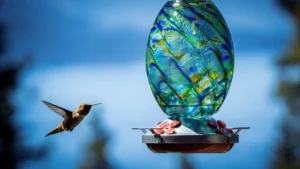Why You Should Keep Hummingbird Feeders Out of Direct Sunlight
Seeing a hummingbird zoom to your feeder is always exciting. You mix up sugar water with care, hoping to give these tiny birds the energy they need. But before you hang that feeder in full sunlight, it’s important to think twice. Sunlight can actually make the nectar go bad and cause problems for hummingbirds. Let’s explore why placing your feeder in the shade is better for their health and comfort.
1. Nectar Goes Bad Faster in the Sun
Think about leaving a sugary drink outside on a hot summer day. It gets warm, cloudy, and might even smell weird after a while. The same thing happens with hummingbird nectar in direct sun. Sunlight heats the feeder, making it a perfect place for bacteria, mold, and yeast to grow.
These germs feed on the sugar and break it down, which changes the nectar. It can turn cloudy, stringy, or smell bad. Even if it still looks okay, the heat may already have reduced its nutrition. For hummingbirds, who need high-energy food, spoiled nectar can make them sick — and in serious cases, it can even be deadly.
Putting the feeder in the shade helps keep the nectar cooler and fresh longer, reducing the risk of harmful bacteria.
2. Warm Nectar Isn’t Tasty
Would you rather drink a warm soda or a cold one? Hummingbirds likely feel the same way about their food. In the wild, flower nectar is usually shaded, so it stays cooler. When nectar in a feeder gets too warm, it may not taste right to them.
Hummingbirds may avoid feeders in the sun because the nectar doesn’t taste as fresh. They might prefer shaded feeders that keep the nectar closer to the natural temperature they’re used to. If your goal is to attract more hummingbirds, keeping the feeder out of the sun can make a big difference.
3. Hot Feeders Can Cause Dehydration
When nectar is in the sun, the water in it evaporates faster. This makes the mixture thicker and less hydrating. Hummingbirds already need a lot of water because they burn so much energy flying around. On hot days, they need even more hydration to stay cool and healthy.
Also, a feeder in full sun usually doesn’t offer shade for resting. This forces the birds to spend more time in the heat, raising their risk of overheating. Shade helps them stay hydrated, cool, and gives them a spot to rest between feedings — especially important for young or sick birds.
4. Pests Love Hot Feeders
Sunlight speeds up nectar spoilage, which attracts bees, wasps, and ants. As the nectar ferments and thickens, it gives off a stronger smell. This smell attracts more pests from farther away.
Sticky nectar from evaporation or pests crawling around the feeder can be a mess. Wasps and bees can get aggressive, scaring away hummingbirds. Ants can get into the feeder and spoil the nectar too. Once bugs find a feeder in the sun, it can be hard to get rid of them.
Placing your feeder in the shade not only keeps nectar fresh, but also helps prevent pest problems that might drive hummingbirds away.
5. Shade Helps Hummingbirds Save Energy
Flying takes a lot of energy, especially under the hot sun. If your feeder is in a sunny, open area, hummingbirds might have to work harder just to reach it. In the shade, they can fly shorter distances, rest nearby, and use less energy.
Shaded feeders, especially those near trees or shrubs, give hummingbirds a comfortable place to eat and rest. This setup encourages them to visit more often and stay longer — a win for both the birds and the birdwatchers.
Final Thoughts
Hummingbirds are amazing creatures with incredibly high energy needs. When you hang your feeder in a shady spot, you’re helping them stay safe, cool, and well-fed. It keeps the nectar fresher, reduces pests, and helps these tiny birds save energy. You’ll likely notice that shaded feeders get more visits, especially during the hottest part of the day.
So, the next time you put out your hummingbird feeder, look for a spot with some shade. A little change in placement can make a big difference in helping these beautiful birds stay healthy and happy.
FAQs
Q1: Can I put my hummingbird feeder in the sun at all?
A: It’s best to avoid full sun, especially during the hottest parts of the day. If sun exposure is unavoidable, try placing the feeder where it gets morning sun and afternoon shade.
Q2: How often should I change the nectar in the summer?
A: In hot weather, change the nectar every 1–2 days to prevent spoilage. In cooler weather, every 3–4 days is usually fine.
Q3: What’s the best nectar recipe for hummingbirds?
A: Mix 1 part white sugar with 4 parts water. Boil the water to help dissolve the sugar, then let it cool completely before filling the feeder. Do not add red dye or honey.
Q4: How do I keep ants and bees away from the feeder?
A: Use ant moats above the feeder and choose feeders designed to be bee-resistant. Keeping the feeder in the shade also helps reduce insect attraction.

